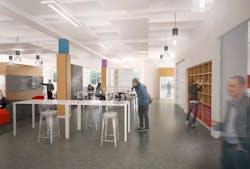Maker spaces: Designing places to test, break, and rebuild
“Making is part of our DNA”, says Shane Farritor, referring to the culture at the University of Nebraska-Lincoln (UNL). Farritor is the founder and faculty sponsor of the Nebraska Innovation Studio, a new maker space designed by Gensler that is part engineering lab, part art studio, and part business accelerator.
“There are so many talented people who grow up in rural areas building and creating things. It’s one of the things I most respect about the state,” he says.
Farritor grew up tinkering in his family’s hardware store, and eventually went onto earn a Ph.D. at MIT, where he spent many hours in the MIT Hobby Shop—a unique extracurricular facility where students have access to sophisticated equipment, but with the freedom to pursue their own projects.
Like many schools, MIT is seeking to close the gap between academia and industry, and give its students a jump start on the creation of future ventures.
The Institute makes this resource available, in large part, because of a deeply-held belief that hands-on experimentation develops important problem solving and analytical skills. Perhaps equally important, the Hobby Shop provides an outlet for exploration of personal interests outside of curricular requirements.
At MIT, the emphasis on hands-on learning dates back to the Institute’s origins, and is a central ingredient of the pedagogy. The Institute’s seal features two figures: a scholar and a craftsman, illustrating the motto “Mens et Manus,” or Mind and Hand. It is through the process of building and experimenting that abstract concepts become real.
For the International Design Center—a collaboration between MIT and the Singapore University of Technology and Design—this philosophy was the key to bringing together a multidisciplinary group of faculty and students addressing a shared set of problems across the developing world.
The researchers came from fields as diverse as computer science, electrical engineering, architecture, even behavioral science, and had never previously worked together. But what united them was a common process of brainstorming, prototyping, evaluating/testing, and then re-designing.
It was critical that the design of the space support this process by making it easy to work back and forth between areas of focus work, prototyping shops, and collaboration spaces. So rather than provide dedicated spaces for each group, everyone works together in open, shared workspaces based on function. This strategy promotes the exchange of ideas between groups, and ultimately provides fertile ground for innovation.
Maker spaces are also an important component of academic incubators. In another project for MIT, Gensler was asked to help create the program and parameters for a facility that would form the catalyst for innovation and entrepreneurship on campus.
Like many schools, MIT is seeking to close the gap between academia and industry, and give its students a jump start on the creation of future ventures. In this case, the “sandbox” is the central piece of a larger program that includes places to meet with collaborators and advisors, places to socialize with students from different disciplines, places to attend talks by established entrepreneurs, and other support spaces.
Back at the UNL Nebraska Innovation Studio, many of these same elements come together. The Studio is located on the larger Nebraska Innovation Campus, which is based on the premise of connecting university and private sector talent “to transform ideas into innovation that impacts the world.” It is a symbiotic relationship in which the University benefits by exposure to private sector expertise, and businesses benefit by access to cutting-edge research and emerging talent. The Studio will feature a business accelerator in which industry partners will act as mentors to student teams. Not only will students have the physical resources to develop ideas, but the support to turn inventions into business ventures.
Perhaps the most compelling aspect of the Innovation Studio is the mix of disciplines it brings together. In addition to metal working, wood working, rapid prototyping, and electronics shops, there is also an art studio which accommodates ceramics, printmaking, sculpting, painting, sewing, and a darkroom. Taken separately, there is nothing new about any of these—they all currently exist in distributed locations on campus. However what is novel about the maker space concept, is that it provides all of the tools in one location, so that anything that can be envisioned can be created. And perhaps most importantly, it brings people together from different backgrounds with different areas of expertise. It is precisely this recipe that lays the foundation for innovation.
About the Authors: Kenneth I. Fisher, FAIA, LEED AP, is a Principal and Studio Director in Gensler Boston and a Firmwide Leader of Gensler’s Education Practice Area leader. His decades of experience include campus planning and the design of academic and institutional facilities. He has directed multiple teams on the design and implementation of maker spaces and draws from his time as a graduate researcher in physics, working in the lab, late into the night. Contact him at [email protected].
Keller Roughton, AIA, LEED AP, is a Senior Associate in Gensler’s Boston office. His work includes several student-focused innovation studios and maker spaces from MIT to the University of Nebraska. A “maker” at heart, he grew up building elaborate tree forts and skateboard ramps and dreams of the day he can have his own shop to tinker in. Contact him at [email protected].
About the Author
Gensler
A global design firm with more than 5,000 practitioners networked across five continents, Gensler features insights and opinions of architects and designers on how design innovation makes cities more livable, work smarter, and leisure more engaging. Our contributors write about projects of every scale, from refreshing a retailer’s brand to planning a new urban district, all the while explaining how great design can optimize business performance and human potential. For more thought leadership and blog content, visit our Research & Insight page. Follow us on Facebook, LinkedIn, and Twitter.
